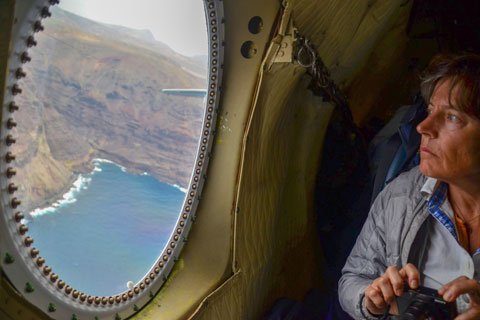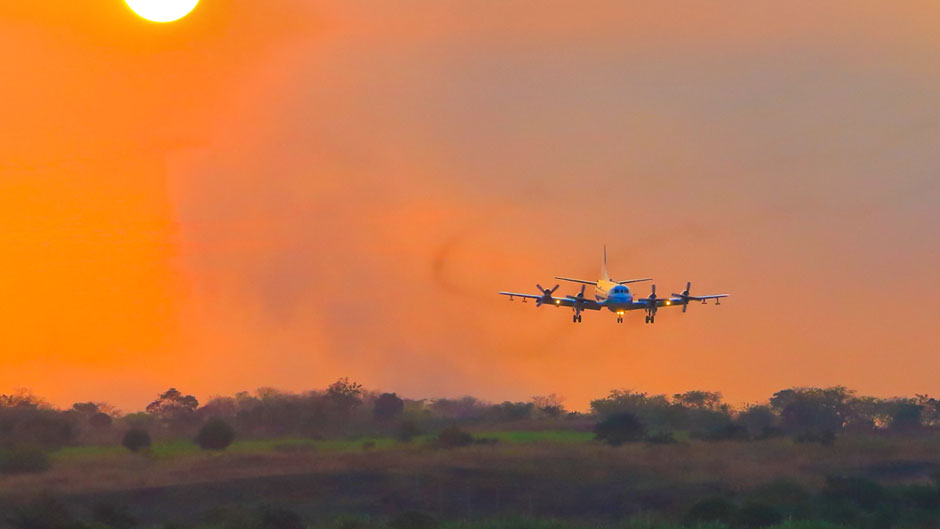Inside a hangar on the African island of São Tomé, crewmembers begin preparing a Lockheed P-3 aircraft for takeoff. University of Miami atmospheric scientist Paquita Zuidema is already on-site, going over an extensive checklist of mission-critical instruments for the long flight ahead.
Zuidema and the nearly 20 other researchers who would board the four-engine turboprop were not bound for an exotic destination, but an area over the southeast Atlantic Ocean, where for the next eight hours they would zigzag through the clouds and a layer of smoke, taking instrument readings of the surrounding atmosphere.
Such was a typical flight day for an international team of scientists studying how smoke generated by agricultural fires in Africa interacts with clouds and in turn affects regional and global climate.
Southern Africa produces about a third to one half of the planet’s biomass burning aerosol particles, enough to create a 2,000-mile-long plume of smoke that stretches all the way to Brazil. “It’s quite large, but we don’t think of it that much because it’s in the Southern Hemisphere,” said Zuidema, a professor at UM’s Rosenstiel School of Marine and Atmospheric Science and co-principal investigator of the five-year NASA-funded ORACLES (Observations of Aerosols Above Clouds and Their Interactions) project.
“At the same time that you have this thick smoke layer, underneath it is one of the largest stratocumulus cloud decks in the world,” she said. “And the combination of smoke and clouds generates enough atmospheric warming that it affects regional precipitation patterns.”
Learning more about this interaction between aerosols and clouds is at the heart of ORACLES.
 For the past three years, Zuidema and two of her graduate students have joined a team of scientists from around the world on one-month deployments to study the phenomena, flying aboard a NASA P-3 aircraft chockfull of remote sensing equipment and sensors that gather samples from both the cloud and smoke layers through air inlets on the plane’s wings and windows. A high-altitude ER-2 aircraft, manned only by a single pilot outfitted in a spacesuit and helmet, was used in the early phases of the project.
For the past three years, Zuidema and two of her graduate students have joined a team of scientists from around the world on one-month deployments to study the phenomena, flying aboard a NASA P-3 aircraft chockfull of remote sensing equipment and sensors that gather samples from both the cloud and smoke layers through air inlets on the plane’s wings and windows. A high-altitude ER-2 aircraft, manned only by a single pilot outfitted in a spacesuit and helmet, was used in the early phases of the project.
The team’s first deployment was in September 2016 out of Namibia. In August 2017 they flew out of São Tomé in the Gulf of Guinea, returning to that site last October for what would be the last survey.
The research missions coincided with the height of the burning cycle in Africa fall, when farmers burn their fields after harvest to return nutrients to the soil.
All told, researchers logged more than 300 hours of flight time, gathering data that revealed a wealth of new information. “We’ve been able to characterize these smoke layers better than has ever been done before,” said Zuidema. “What we’ve learned is that the smoke permeates the whole middle atmosphere and interacts quite strongly with the cloud deck below, and that means more pollution that’s actually mixing into this low cloud deck, which we didn’t know beforehand. And that has all kinds of ramifications for longevity and precipitation.”
Specifically, clouds that are more polluted than others can last longer and generate less precipitation, she noted.
Researchers have one year of funding left to analyze their data, which could be applied to other regions around the world where aerosols from wildfires and industry interact with clouds. Their data could also help produce better climate models.
“We’re taking our observations and, in one step, comparing them to climate model output to try to develop more confidence in the models themselves,” explained Zuidema. “And those models will be used to actually conduct cause-and-effect studies.
“One thing that’s hard with observations is that you’re never quite sure what’s the egg and what’s the chicken,” she continued. “So you really need models to do that. We just haven’t had much confidence with models in that part of the world. They predict either a climate cooling or a climate warming. So that’s our next step—to see if these interactions between the smoke and the clouds are being represented accurately and what they mean.”
And in what Zuidema calls "new and exciting fundamental research," investigators are studying the properties of aged smoke—smoke that is more than a week old.
"The southeast Atlantic is a natural testbed for this because the smoke just sits there day after day, baking in the sun," she said. "We are finding the smoke’s ability to absorb sunlight increases with age. This is new and important, as it also has climate ramifications, and this long-term aging process is not represented yet in leading models."
For Amie Dobracki, a UM graduate student in atmospheric science, the experience of participating in all three deployments of the ORACLES project was invaluable. Of all the researchers who flew aboard the P-3 aircraft, Dobracki amassed the most flight time, operating and maintaining the aerosol mass spectrometer and other in situ instruments as well as uploading data post flight.
“It truly was a hands-on learning experience,” she said. “I was more than 5,000 miles away from home, so troubleshooting and repairing instruments in the field with the supplies at hand was an incredible challenge. I couldn’t just order a new part or find a replacement. I had to be ready for any part to break down at any time, so from that I learned preparation skills and how to think outside the box.”
During her only ORACLES deployment last month, second-year atmospheric graduate student Sara Purdue collected different filter samples and assisted in operating some of the onboard instruments. “Having an opportunity to participate provided me with tremendous insight into the data I will be using for my dissertation,” she said. Also beneficial to her, she said, was “the chance to work with some incredible scientists I hope to collaborate with in the future.”

